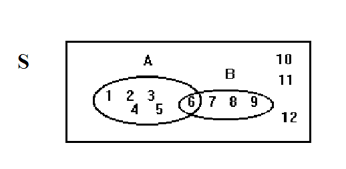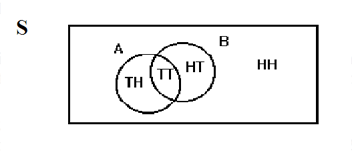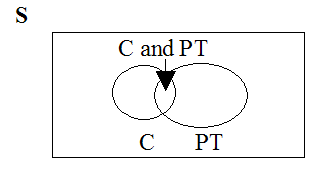-
Home
- Collaborative statistics (custom
- Probability topics
- Venn diagrams
This module introduces Venn diagrams as a method for solving some probability problems. This module is included in the Elementary Statistics textbook/collection as an optional lesson.
A
Venn diagram is a picture that represents the outcomes of an experiment. It generally consists of a box that represents the sample space S together with circles or ovals. The circles or ovals represent events.
Suppose an experiment has the outcomes 1, 2, 3, ... , 12 where each outcome has an equal chance of occurring. Let event
and event
. Then
and
. The Venn diagram is as follows:

Flip 2 fair coins. Let
= tails on the first coin. Let
= tails on the second coin. Then
and
.
Therefore,
.
.
The sample space when you flip two fair coins is
. The outcome
is in neither
nor
. The Venn diagram is as follows:

Forty percent of the students at a local college belong to a club and
50% work part time.
Five percent of the students work part time and belong to a club. Draw a Venn diagram showing the relationships. Let
= student belongs to a club and
= student works part time.

If a student is selected at random find
Questions & Answers
A golfer on a fairway is 70 m away from the green, which sits below the level of the fairway by 20 m. If the golfer hits the ball at an angle of 40° with an initial speed of 20 m/s, how close to the green does she come?
A mouse of mass 200 g falls 100 m down a vertical mine shaft and lands at the bottom with a speed of 8.0 m/s. During its fall, how much work is done on the mouse by air resistance
Can you compute that for me. Ty
Jude
what is the dimension formula of energy?
Chemistry is a branch of science that deals with the study of matter,it composition,it structure and the changes it undergoes
Adjei
please, I'm a physics student and I need help in physics
Adjanou
chemistry could also be understood like the sexual attraction/repulsion of the male and female elements. the reaction varies depending on the energy differences of each given gender. + masculine -female.
Pedro
A ball is thrown straight up.it passes a 2.0m high window 7.50 m off the ground on it path up and takes 1.30 s to go past the window.what was the ball initial velocity
2. A sled plus passenger with total mass 50 kg is pulled 20 m across the snow (0.20) at constant velocity by a force directed 25° above the horizontal. Calculate (a) the work of the applied force, (b) the work of friction, and (c) the total work.
you have been hired as an espert witness in a court case involving an automobile accident. the accident involved car A of mass 1500kg which crashed into stationary car B of mass 1100kg. the driver of car A applied his brakes 15 m before he skidded and crashed into car B. after the collision, car A s
can someone explain to me, an ignorant high school student, why the trend of the graph doesn't follow the fact that the higher frequency a sound wave is, the more power it is, hence, making me think the phons output would follow this general trend?
Nevermind i just realied that the graph is the phons output for a person with normal hearing and not just the phons output of the sound waves power, I should read the entire thing next time
Joseph
Follow up question, does anyone know where I can find a graph that accuretly depicts the actual relative "power" output of sound over its frequency instead of just humans hearing
Joseph
"Generation of electrical energy from sound energy | IEEE Conference Publication | IEEE Xplore" ***ieeexplore.ieee.org/document/7150687?reload=true
Ryan
what are the types of wave
Maurice
fine, how about you?
Mohammed
A string is 3.00 m long with a mass of 5.00 g. The string is held taut with a tension of 500.00 N applied to the string. A pulse is sent down the string. How long does it take the pulse to travel the 3.00 m of the string?
Who can show me the full solution in this problem?
Got questions? Join the online conversation and get instant answers!
Source:
OpenStax, Collaborative statistics (custom lecture version modified by t. short). OpenStax CNX. Jul 15, 2013 Download for free at http://cnx.org/content/col11543/1.1
Google Play and the Google Play logo are trademarks of Google Inc.



